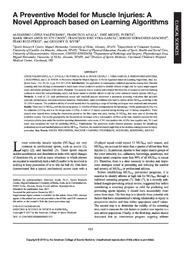Título :
A Preventive Model for Muscle Injuries: A Novel Approach based on Learning Algorithms |
Autor :
López-Valenciano, Alejandro
Ayala, Francisco
Puerta, José Miguel
Amos DE Ste Croix, Mark Brian
Vera Garcia, Francisco José
HERNANDEZ-SANCHEZ, SERGIO 
Ruiz-Pérez, Iñaki
Myer, Gregory D |
Editor :
American College of Sports Medicine |
Departamento:
Departamentos de la UMH::Patología y Cirugía |
Fecha de publicación:
2018 |
URI :
https://hdl.handle.net/11000/31309 |
Resumen :
Introduction: The application of contemporary statistical approaches coming from Machine Learning and Data Mining environments to build more robust predictive models to identify athletes at high risk for injury might support injury prevention strategies of the future. Purpose: The purpose was to analyze and compare the behavior of numerous machine learning methods to select the best-performing injury risk factor model to identify athlete at risk for lower extremity muscle injuries (MUSINJ). Methods: A total of 132 male professional soccer and handball players underwent a preseason screening evaluation that included personal, psychological, and neuromuscular measures. Furthermore, injury surveillance was used to capture all the MUSINJ occurring in the 2013/2014 seasons. The predictive ability of several models built by applying a range of learning techniques were analyzed and compared. Results: There were 32 MUSINJ over the follow-up period, 21 (65.6%) of which corresponded to the hamstrings, 3 to the quadriceps (9.3%), 4 to the adductors (12.5%), and 4 to the triceps surae (12.5%). A total of 13 injures occurred during training and 19 during competition. Three players were injured twice during the observation period so the first injury was used, leaving 29 MUSINJ that were used to develop the predictive models. The model generated by the SmooteBoost technique with a cost-sensitive ADTree as the base classifier reported the best evaluation criteria (area under the receiver operating characteristic curve score, 0.747; true positive rate, 65.9%; true negative rate, 79.1) and hence was considered the best for predicting MUSINJ. Conclusions: The prediction model showed moderate accuracy for identifying professional soccer and handball players at risk for MUSINJ. Therefore, the model developed might help in the decision-making process for injury prevention.
|
Tipo de documento :
info:eu-repo/semantics/article |
Derechos de acceso:
info:eu-repo/semantics/openAccess
Attribution-NonCommercial-NoDerivatives 4.0 Internacional |
DOI :
https://doi.org/10.1249/MSS.0000000000001535 |
Publicado en:
Medicine & Science in Sports Exercise . 2018 May;50(5):915-927 |
Aparece en las colecciones:
Artículos Patología y Cirugía
|

 La licencia se describe como: Atribución-NonComercial-NoDerivada 4.0 Internacional.
La licencia se describe como: Atribución-NonComercial-NoDerivada 4.0 Internacional.
.png)